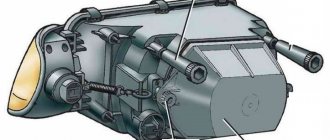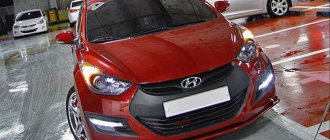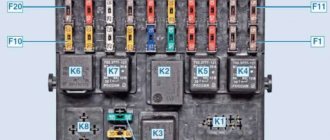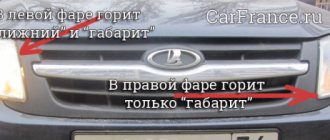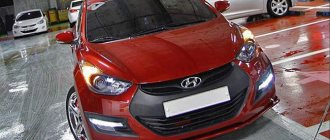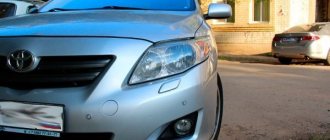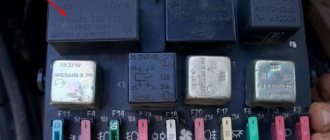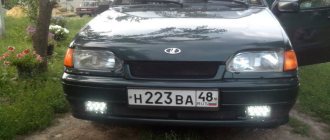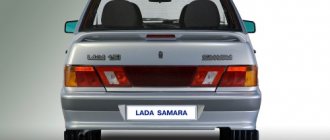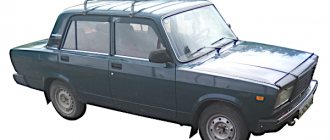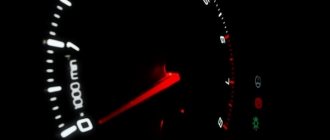LED bulbs
LED lamps are rarely installed in headlights, they are also called LED, they should not be confused with LED matrix headlights, the operating principle is the same, the technology and design diagrams are different. LED is a crystal. An LED lamp is a housing containing a board with crystals, an ice-driver that ensures operation at low currents, and a number of other devices, depending on the design of the lamp and its functional purpose. The operating principle is simple. An electric current is supplied through the ice driver, an electric field appears that affects the atoms, and then the recombination of electrons and holes and photon radiation occurs, that is, a glow occurs.
The power sources in matrix and laser headlights are also LEDs, but they have a fundamentally different operating scheme, which we will not dwell on in detail in this article.
What's the truth?
They were allowed to drive during the day without headlights - this is the truth. But not in Russia. The corresponding decree was issued by the authorities of Transnistria, an unrecognized state of the Moldavian Republic... 2 years ago
How this news suddenly spread to Russian traffic regulations remains a mystery. But the fact remains - in Transnistria, indeed, from April 1 to September 30, you can not turn on low beam headlights during the day (video about this), but Russian traffic rules in this regard have not changed.
Revisions of traffic regulations
Another argument against changes in the Traffic Rules is the edition of the traffic rules. With each change, a new edition comes into force. Today, the most up-to-date database on them is contained on the Consultant Plus website. And here you will find 3 editions: one that entered into force on March 18, 2021, and 2 more that are pending.
But most importantly, none of them has in the list of changes section 19 of the traffic rules, which specifically concerns lighting devices.
As you can see, no changes have been introduced to the traffic rules since April 1, 2021, and you still need to turn on your headlights during the day.
What color of side lights is allowed according to traffic regulations?
If the color of the light device does not meet the standard requirements established for the type of vehicle, the traffic regulations prohibit the operation of such a vehicle.
Requirements for external lighting of vehicles are established by GOST 8769-75. The terms of the standard determine that the front dimensions must emit a white color, and the rear dimensions must emit a red color (Clause 2.5.6).
We recommend: How to properly secure a child seat in a car?
Requirements for the color of side markers are established by GOST R 41.91-99: it must be yellow.
Adjusting headlights VAZ 2110
Check and adjust the headlights on an equipped vehicle with a full tank of fuel, a set of tools and a spare tire.
1.Check and, if necessary, check the air pressure in the tires.
2. Place the vehicle perpendicular to a smooth wall (eg garage) at a distance of 5 m. Place an additional load of 75 kg on the driver's seat. Mark the screen on the wall as shown in Figure 1. The longitudinal plane of symmetry of the car should run along line 0 on the screen.
3.Take your car to the height of the headlights to the floor. This will be the distance h on the screen (for a new car h = 600 mm).
4. Turn on low
light.
5. Turn the rotary switch to position “I” (driver and front passenger).
6.Open the hood and adjust the position of the light spot for each headlight on the screen, if the position of the light spots on the screen does not match the picture, with screws 1 (horizontal plane) and 2 (vertical plane) manual beam adjustment.
7. Adjust the direction of the light spot for each headlight separately. Cover the second headlight during adjustment with an opaque material.
8. The headlight light is considered adjusted if the upper limit of the left parts of the light spots coincides with line N, and the vertical lines A and B pass through the intersection points C1 and C2 of the horizontal and the inclined areas of the light spots.
Stopping and parking a car
At night on an unlit road
Must be included:
- parking lights.
It is prohibited to use:
- fog lamp.
Other lighting devices can be used.
In case of insufficient visibility (during dark or daylight)
Must be included:
- parking lights.
Other lights, including the rear fog lamp, may be used.
How Light Assist works
The operating conditions of the complex will depend on the type of headlights installed. If the headlights are halogen, then automatic switching occurs between low and high beam depending on the situation on the road. With xenon headlights, the reflective element in the headlight automatically rotates in different planes, changing the direction of the light. This system is called Dynamic Light Assistant.
The main components of the device are:
- Control block;
- interior lighting mode switch;
- black and white video camera;
- headlight module (reflective element);
- light sensors;
- dynamic control sensors (wheel speed).
To activate the system, you must first turn on the low beam, then switch the switch to automatic mode.
The black and white video camera and control unit are located in the rearview mirror. The camera analyzes the road situation in front of the car at a distance of up to 1,000 meters. It recognizes light sources and then transmits graphic information to the control unit. This means that the source (an oncoming vehicle) is recognized before it is blinded. The length of the high beam light beam usually does not exceed 300-400 meters. The high beam automatically turns off when an oncoming vehicle enters this area.
Camera and light sensor in the rear view mirror
The control unit also receives information from light sensors and wheel speed sensors. Thus, the control unit receives the following information:
- level of illumination on the road;
- speed and trajectory of movement;
- the presence of oncoming light flow and its power.
Depending on the traffic situation, the high beams are automatically turned on or off. The operation of the system is indicated by a control lamp on the instrument panel.
Kind of light
There are the following types of car headlights:
- Dimensions. Installed in front and behind the car to visually determine the dimensions of the car.
- High and low beam optics. Often both lamps are located in the same housing or one lamp is used, which provides both a near-field, 40-50 meters, and a long-range, up to 120 meters, stream of light.
- PTF.
- Running lights.
The main technical characteristic of light is color temperature. It determines the spectrum of radiation that can be perceived by the human eye. For automobile lamps, color temperature remains the main parameter of choice, measured in Kelvin. Each light bulb is marked with a cap or base.
Type of light depending on color temperature:
- 2400 Kelvin – rich yellow light.
- 3200 K – weak yellow light, used in the factory configuration for automotive headlight optics.
- 4300 K – warm white light, good road illumination at night.
- 5000 K – light 95% close to daylight.
- 6000 K - light blue light of a cold spectrum; in bad weather it does not provide sufficient visibility of the road.
- 8000 K and above - blue cold light, used in automotive optics as a decorative element; its use for headlights is prohibited.
Halogen
70% of automotive optics use a halogen lamp, which consists of a bulb, an incandescent filament, and a base. Instead of vacuum, there is a halogen gas (a volatile compound of bromine, chlorine, fluorine, etc.), which gives the tungsten filament a lower degree of evaporation and a higher degree of incandescence. The light of a halogen lamp, in comparison with a conventional incandescent light bulb, has greater brightness with an increased length of the luminous flux. Advantages:
- resistance to mechanical stress and vibration due to the use of a quartz flask;
- average service life 2000 hours;
- ease of self-installation, quick dismantling.
Xenon
High-intensity discharge lamps, better known as xenon lamps, are a relatively new technology based on the principle of halogen design. The flask is filled with inert gases (xenon from 70%). The lamp does not have a standard filament; there are two electrodes that ensure the occurrence of an electric arc. Xenon, heating up, begins to shine with bright white light, as close as possible to daylight.
To operate effectively, it is necessary to generate a voltage pulse necessary to initiate an arc. Cars with xenon optics have a special ignition unit, or “ballast”. Advantages:
- increased light flow;
- high efficiency (45% higher than halogen analogues);
- service life up to 10,000 hours;
- small load on the car generator;
- good visibility when driving at night.
Xenon lamps are characterized by a color value of 4300 K. These are the best temperature indicators at which good visibility is ensured at night and during bad weather. Lamps labeled 5,000 K produce light that is 98% similar to daylight.
Diode
Diode optics, or LED headlights, are a new word in automotive lighting. Until recently, diodes were used one at a time for interior lighting, daytime running lights, and backlighting. The LEDs are equipped with an ice block and installed in lensed optics. Advantages of installing LEDs:
- minimal energy consumption;
- service life more than 10,000 hours;
- at a color temperature of 5000 K, LED lamps provide white light and increased brightness;
- It is permissible to use LEDs in a regular lensed headlight.
The disadvantages of ice lighting include the cost of the diode unit, which, if one element breaks, must be completely replaced.
Laser
As an innovation, a new element is included in the optics of the car - laser headlights. The high cost of manufacturing a laser unit is so far the only limitation to the widespread use of the new technology.
For the first time, it was the Chinese who decided to install a laser beam on conventional LEDs. At the same time, the luminous flux of the ice element increased by 70%. Laser headlights are equipped with a certain number of diodes and a laser module; the light beam has clear boundaries and does not blind oncoming drivers.
The color temperature does not exceed 5500 K, which provides good illumination of the road at night, in fog, during heavy snow and rain. The built-in infrared camera also contributes to better illumination (only in luxury cars, for example Audi Sport 2018).
Incandescent lamps
An incandescent lamp is a traditional solution. Its operating principle is based on the fact that there is a filament body, a spiral made of refractory metal (let’s not talk about exotic things, most often it is tungsten), an electric current of a certain voltage is supplied to it. An incandescent body placed in a sealed flask (in the flask there is either a vacuum or an inert gas) heats up and, according to Planck’s law, electromagnetic-type thermal radiation occurs; simply put, the light bulb begins to glow. There will be no more details about color temperature and other criteria, a topic for a dissertation, and traditional incandescent lamps in headlights are gradually being abandoned, although they are found on budget models.
Possible causes of malfunction
So, if the low beam in one of the headlights of a Lada Kalina does not light up, then the reason most likely lies in a burnt-out light bulb. Replacing it will not be difficult for every car owner.
However, unfortunately, there are a number of other reasons for this malfunction, the most common of which are the following:
How to improve headlights on a car
- The contacts in the plug block are oxidized or burnt;
- The fuse has blown;
- Open circuit;
- The relay has failed.
Below we will look at how to fix all these problems.
H7 standard bulb
Replacing the lamp
Replacing the low beam on Kalina is quite simple. Moreover, you will only have to spend a few minutes of your time on this.
The only thing is that before replacing old lamps, you need to purchase new ones of the H7 standard. It is advisable to install new bulbs on two headlights at once so that they provide the same glow.
Removing the plug
Replacement instructions are as follows:
- First of all, you need to remove the rubber plug located on the back of the headlight. To do this, you must first open the hood.
- Then you need to remove the positive and negative terminals from the contacts.
Releasing the latch from the landing
- Next, you need to press the spring bracket with your own hands and remove it from the seat.
- After this, you need to remove the old light bulb and put a new one in its place.
- Then you need to replace the bracket, put the terminals on the contacts and install the plug.
When replacing light bulbs, you need to pay attention to the quality of the contacts. If the contacts are oxidized or burnt, they must be cleaned
Fuse and relay block Lada Kalina
How does an oil filter work in a car?
Replacing the fuse
If, after replacing the lamps, the low beam headlights in the Lada Kalina still do not work, you should check the fuses. They are located in the mounting block under the steering wheel.
The lamps are protected by different fuses:
- Right lamp – F12
- Left lamp – F13
It must be said that it is not always possible to visually identify a blown fuse. Therefore, even if it has no external defects, you should check the voltage at the terminals with a test lamp or multimeter.
Lada exterior lighting diagram
Open circuit
If the fault cannot be eliminated, then you need to find an open circuit.
You can do this as follows:
- If there is no voltage at the fuse terminals, you need to ring the wire that goes from F13 to contact No. 56 of the lighting control unit, since you can turn on the low beam headlights on Kalina using switch No. 5.
- If the wire is intact, but 2 headlights do not light, then switch No. 56 must be replaced. However, you should first check whether voltage is supplied to the switch itself.
- If voltage is supplied to fuses F13 and F12, you should check whether there is voltage at the relay output. Let us remind you that the low beam relay in the Lada Kalina is located in the mounting block.
- If there is no voltage, you should check the area from F12 to contact No. 56 of switch No. 4, which is located on the steering wheel, as well as the area from terminal No. 56a to terminal 1 of relay K7. It is also quite possible that switch No. 4 or the relay itself is not working.
Replacing the latter is not difficult, since it is simply inserted with contacts into the socket.
In the photo - lighting relay Lada Kalina
In cases where there is voltage at the relay output, you should check the wiring of the machine from the mounting block to the headlights according to the diagram.
How to change spark plugs in a car
As we can see, finding an open circuit or a faulty part is not difficult. To do this, you only need a low beam circuit on Kalina and a multimeter or test light. These are, perhaps, all the main reasons for this malfunction on the Lada Kalina car.
Design Features
VAZ 2101 fuse box: purpose, malfunctions and repairs
Lamps
.
Cars use pod lights that combine passing and leading lights (single thread bulbs) and turn indicators. In addition, the headlights have parking light bulbs. The low and high headlight beams are activated using auxiliary relays K4 and K5 located in the mounting block. The control voltage to the relay coils is supplied from the headlight switch when the headlight switch switch is fully pressed. When the low beam is on, the low beam lamp illuminates, and when the high
, all lamps (passing and driving) are illuminated.
turn on
in no time by pulling the light switch lever towards you.
In this case, the voltage at contact “30” of the switch is supplied directly from the power sources. In the wiring harness of wiring harness B for connecting the wires when installing headlights with low beam lamps with double hood. In this case, the gray wire with a red stripe in connector B must be connected to the same color wire as the switch's "56b" connector. Then, when the low
, the low beam bulb in the double brake lamps comes on, and when the high beam beam is switched on, the high beam bulbs in the double brake lamps and the headlight come on.
Fog lights
.
On VAZ 2110 vehicles, in the optional version, fog lights can be installed on the front bumpers. The headlights are switched on by switch 27 (see Instrument panel) using an additional relay type 113.3747 installed in a shoe attached to the rear side of the mounting block. The fog lights can only be turned on if the exterior lighting
26 is turned on.
Accelerated self-training course for novice drivers: Sign up for lessons.
https://youtube.com/watch?v=6XsMfAPBhtw
HOW TO CONNECT AUTOMATIC LOW BEAM
, THERE IS CONTROL OF LIGHT OPERATION AND.
Outdoor Lighting
. The ambient light is turned on by the external lighting switch 26 (in positions “I” and “II”). The parking light and brake light lamps are supplied via lamp control relay K1. If any lamp is on, the relay is activated by the corresponding LED indicator in block 5 (see Instrument panel) of the on-board monitoring system.
Direction indicators
. The direction indicators for the starboard or port side are activated using the switch lever. In emergency mode, switch 42 turns on all direction indicators. The flashing of the lamps is ensured by the KZ relay switch in the mounting block.
Light and sound devices of the car and their location
We should start with the basics, or rather with what types of headlights and lanterns modern cars are equipped with.
- Low beam headlights - designed to illuminate the road and surrounding area in a relatively small area.
- High beam headlights are powerful lighting devices that illuminate the roadway over a fairly large area. Due to its high brightness, high beams can blind oncoming drivers.
- Front fog lights - installed lower than conventional headlights, create a wide beam of light that well illuminates the road and the surrounding area in conditions of fog, snowfall and rain.
- Daytime running lights are a separate type of headlights that are turned on during the day, regardless of weather or visibility, and are designed to increase the visibility of vehicles. Most models turn on immediately when the engine starts.
- Tail lights - designed to identify the vehicle at night or in poor visibility conditions. The color of the lamps is red.
- Brake lights are red lights that come on when a vehicle slows down. They burn much brighter than the side lights. Some cars are additionally equipped with a central brake light.
- Rear fog lights - indicate the vehicle in fog, rain or snowstorm conditions. Not to be confused with brake lights.
- Reversing lights are white and are designed to inform pedestrians and other motorists that the vehicle will be moving (or is already moving) in reverse.
- Rear reflectors - used for the same purpose as side lights, they reflect the light falling on them from the headlights of passing cars. May also be known as retroreflectors.
- License plate lighting – several white bulbs designed to illuminate the rear license plate of a vehicle.
- Turn signals, or “turn signals,” are amber lights that are used to inform you that the vehicle is turning or otherwise maneuvering. Installed in the corners and on the sides of the car.
Rules for using external lighting devices at night
At night, or the dark time of the day, the rules refer to the period of time between the end of the evening and the beginning of the morning twilight. In such conditions, it is mandatory to turn on the headlights and side lights.
The choice of low or high beam depends on the following nuances:
- If you are driving along illuminated roads in a populated area , you cannot use high beams, only low beams.
- When approaching a vehicle moving in the oncoming lane, the high beams should be switched to low beams at least 150 meters in advance - this way you will not blind the other driver. It’s even better to switch at 200-250 meters.
- If an oncoming vehicle signals by switching or flashing its headlights at a greater distance , turn off the high beams. In such situations, your headlights are most likely poorly adjusted, and they do not so much illuminate the road as they shine into the eyes of oncoming drivers.
- You also need to switch the lights in other situations when there is a threat of blinding other drivers , both oncoming and passing.
What to do if you are blinded? The main thing is not to change lanes, otherwise there is a risk of getting into an accident, hitting a pedestrian or falling into a ditch. The rules require in such a situation to turn on the hazard warning lights, gradually reduce speed and, if necessary, stop.
We recommend: Selecting and changing the fog lamp bulbs yourself
Forced stop in the dark - be sure to turn on the side lights and, if desired, supplement them with low beams and fog lights.
Lamp characteristics
Keep in mind that the lamps in the headlights differ in the type of connector, type of base, power and other parameters. Remember, we already mentioned that the holder can be threaded or pin (bayonet)? Moreover, we should immediately note that standard plinths are used, but some manufacturers earn extra money as magicians, using a non-standard contact group, located, for example, in the plinth, or non-standard fasteners. Take this into account when choosing non-original headlight lamps on our auto portal; you may need an adapter, or a lamp whose design includes an adapter.
There are a huge number of types of sockets that are used in headlights. Of course, there are general labeling rules. All halogen lamps are marked starting with the letter “H”, which in English means Halogen. European manufacturers predominantly use the H marking, and Japanese and American HB.
Xenon lamps are marked with the letter “D”, which in English is Discharge, literally translated into Russian – gas discharge. The fact is that xenon lamps are also called gas-discharge lamps. And pay attention to the markings. After the letter D there is a number that indicates the operating parameters, it can be 1 (with ignitor), 2 (bi-xenon), 3 (without mercury with ignitor) and so on. And after the number the letter is either R or S. R indicates installation in reflective optics, S indicates that the lamp is installed in projection optics. For example, D1S or D2R.
If we look at the headlights, we note that in addition to lamps marked H, HB and D, there may be markings R2 (very rarely, these are ancient lamps that were often found on cars about forty years ago, but it happens) and with the index T and the like others. All the necessary information is contained in the current standards, as well as the decoding of each individual lamp. Labeling is a topic for another discussion.

